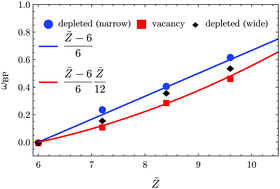Non-affine lattice dynamics of defective fcc crystals
Abstract
The mechanical, thermal and vibrational properties of defective crystals are important in many different contexts, from metallurgy and solid-state physics to, more recently, soft matter and colloidal physics. Here we study two different models of disordered fcc crystal lattices, with randomly-removed bonds and with vacancies, respectively, within the framework of non-affine lattice dynamics. We find that both systems feature the same scaling of the shear modulus with the newly defined inversion-symmetry breaking (ISB) parameter, which shows that local inversion-symmetry breaking around defects is the universal root source of the non-affine softening of the shear modulus. This finding allows us to derive analytical relations for the non-affine (zero-frequency) shear modulus as a function of vacancy concentration in excellent agreement with numerical simulations. Nevertheless, due to the different microstructural disorder, the spatial fluctuations of the local ISB parameter are different in the vacancy and bond-depleted case. The vacancy fcc exhibits comparatively a more heterogenous microstructural disorder (due to the broader distribution of coordination number Z), which is reflected in a different scaling relation between boson peak frequency in the DOS and the average ![[Z with combining macron]](https://www.rsc.org/images/entities/i_char_005a_0304.gif) . These differences are less important at low vacancy concentrations, where the numerical DOS of the vacancy fcc can be well described theoretically by coherent-potential approximation, developed here for the bond-depleted fcc lattice in 3d.
. These differences are less important at low vacancy concentrations, where the numerical DOS of the vacancy fcc can be well described theoretically by coherent-potential approximation, developed here for the bond-depleted fcc lattice in 3d.



 Please wait while we load your content...
Please wait while we load your content...